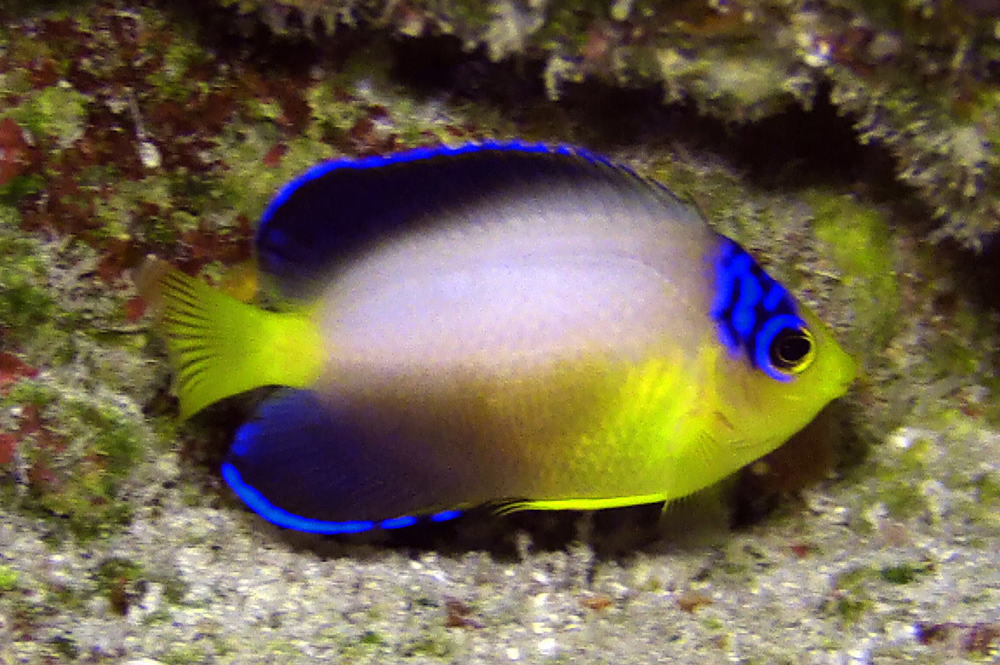Multicolor Angelfish, Centropyge multicolor Randall & Wass 1974
Other Names: Pearlback Angelfish

A Multicolor Angelfish, Centropyge multicolor, in the Marshall Islands, February 2016, depth 25 m. Source: @uwkwaj / iNaturalist.org. License: CC by Attribution-NonCommercial
Summary:
A multicolored pygmy angelfish with a white upper half of body, yellow anteriorly becoming orange to brownish on the abdomen and lower rear of the body, alternating black and bright wavy blue bars on the nape, snout and lower half of head yellow, a broad blackish margin on the dorsal fin, a black anal fin, and yellow pelvic and caudal fins..
Cite this page as:
Bray, D.J. 2022, Centropyge multicolor in Fishes of Australia, accessed 01 Jul 2025, https://fishesofaustralia.net.au/home/species/5657
Multicolor Angelfish, Centropyge multicolor Randall & Wass 1974
More Info
|
Distribution |
Holmes Reef, Coral Sea, Australia. Elsewhere the species occurs in the western-central Pacific: Micronesia, Johnston Atoll, Hawaiian Islands, Fiji, Cook Islands, Society Islands (French Polynesia). Inhabits steep outer reef slopes and drop-offs on deep reefs, usually sheltering among coral rubble or beneath ledges near areas of rich coral growth. |
|
Features |
Dorsal fin XIV,16-17; Anal fin 111,17; Pectoral fin 16-19; Pelvic fin I,5; Caudal fin (principal rays) 17; Gill rakers 6-7+16; Lateral line (tubed scales) 35-37; Vertebrae 10+14. Body moderately deep, depth 1.92 in standard length; caudal fin rounded; first 5-6 interspinous membranes of dorsal fin incised one-fourth or more length of spines; posterior margin of dorsal and anal fins rounded, the rays not extending posterior to mid-length of caudal fin; cirrus at upper end of each interspinous membrane small, not extending above spine tips; no enlarged spines on preorbital. |
|
Biology |
A protogynous hermaphrodite, with typically forming harems comprising three to seven individuals. |
|
Remarks |
This species is known to hybridize with Centropyge ferrugata. |
|
Etymology |
The species is named multicolor for the seven different colours it exhibits in life: white, brown, black, yellow, orange, blue and violet—more than any other species of the genus Centropyge. |
|
Species Citation |
Centropyge multicolor Randall & Wass 1974, Japanese Journal of Ichthyology 21(3): 138, Fig. 1. Type locality: Off ocean reef, Rigili [Leroy] Islet, Enewetak Atoll, Marshall Islands, western Pacific, depth 30 m. |
|
Author |
Bray, D.J. 2022 |
|
Resources |
Multicolor Angelfish, Centropyge multicolor Randall & Wass 1974
References
Allen, G.R. 1980. Butterfly and Angelfishes of the World. New York : John Wiley & Sons Vol. 2 pp. 149-352 figs 214-510.
Allen, G.R., Steene, R. & Allen, M. 1998. A Guide to Angelfishes & Butterflyfishes. Cairns : Odyssey Publishing/Tropical Reef Research 250 pp. figs.
Gaither, M.R., Schultz, J.K., Bellwood, D.R., et al. 2014. Evolution of pygmy angelfishes: recent divergences, introgression, and the usefulness of color in taxonomy. Molecular Phylogenetics and Evolution 74: 38-47. https://doi.org/10.1016/j.ympev.2014.01.017
Myers, R.F. 1999. Micronesian Reef Fishes. A comprehensive guide to the coral reef fishes of Micronesia. Guam : Coral Graphics vi 330 pp. 192 pls.
Pyle, R. 2001. Chaetodontidae, Pomacanthidae. pp. 3224-3286 in Carpenter, K.E. & Niem, V.H. (eds). The Living Marine Resources of the Western Central Pacific. FAO Species Identification Guide for Fisheries Purposes. Rome : FAO Vol. 5 2791-3379 pp.
Pyle, R., Myers, R. & Craig, M.T. 2010. Centropyge multicolor. The IUCN Red List of Threatened Species 2010: e.T165896A6159731. https://dx.doi.org/10.2305/IUCN.UK.2010-4.RLTS.T165896A6159731.en. Accessed on 29 March 2022.
Randall, J.E. 2005. Reef and shore fishes of the South Pacific. New Caledonia to Tahiti and the Pitcairn Islands. Honolulu : University of Hawaii Press 707 pp.
Randall, J.E. & Wass, R.C. 1974. Two new pomacanthid fishes of the genus Centropyge from Oceania. Japanese Journal of Ichthyology 21(3): 137-144. https://doi.org/10.11369/jji1950.21.137
Tea, Y.-K., Hobbs, J.-P.A., Vitelli, F., DiBattista, J.D., Ho, S.Y.W. & Lo, N. 2020. Angels in disguise: sympatric hybridization in the marine angelfishes is widespread and occurs between deeply divergent lineages. Proceedings of the Royal Society B: 2872020145920201459 http://doi.org/10.1098/rspb.2020.1459
Thresher, R.E. & Colin, P.L. 1986. Trophic structure, diversity and abundance of fishes of the deep reef (30-300m) at Enewetak, Marshall Islands. Bulletin of Marine Science 38(1): 253-272. See ref online



